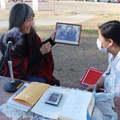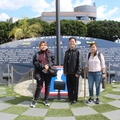I first heard of washi as a kid at the craft store buying rolls of what was advertised to be “washi” tape to decorate my school notebook. It wasn’t until l interviewed washi jewelry maker and teacher Reiko Nakano for Discover Nikkei that I learned about real, traditional washi paper and how it’s used to make all kinds of beautiful creations.
Nakano makes necklaces and other jewelry out of washi, producing creations that are both traditional and unique. She recently taught a workshop at the Japanese American National Museum (JANM) in Los Angeles, sharing the gift of creating washi jewelry with others.
I spoke with her about what led to her passion for washi jewelry and about her journey to washi. I discovered that through washi, we can experience beauty, tradition, and creativity while honoring its roots in traditional Japanese culture.
While there are many people who make homemade washi jewelry, Nakano’s products showcase an exceptional level of quality, using authentic washi paper delivered straight from Japan. Washi paper comes in many colors and designs, many of them inspired by nature, such as detailed floral patterns or the distinctive Japanese crane. The washi is colorful, but not overwhelmingly so. Rather, they give a somewhat vintage feel with its natural, slightly muted color palette.
Washi Basics
So, what exactly is washi? Nakano explains that it is a special paper that originated in Japan. Wa means “Japanese,” and shi means “paper.” While paper itself was introduced to Japan over a thousand years ago, papermaking was adapted by the Japanese to produce washi, which continued to be produced generation after generation.
Washi is distinct from other types of paper as it is traditionally made from materials like bamboo, paper mulberry, wisteria, and hemp. It is also extremely durable, able to last for hundreds of years. Its smooth surface is suitable for placing beautiful designs on it as well. While washi comes from Japan and was long only available there, it now has become popular in other places across the world.
To make washi paper, fibers from the plant materials are collected and soaked in river water. The best paper is produced in the cold winter months, when the water is more pure due to the lower temperatures being less suitable for bacteria that can affect the fibers. The resulting pulp is then spread on a screen to make strong, durable washi paper.
Journey to Washi
Nakano explained that her journey to making washi jewelry actually had its roots in working first with fimo clay. After she retired from her career as a social studies teacher, she began teaching afternoon crafts classes at a Japanese American retirement home, as well as at a church and some elementary schools.
She discovered that fimo clay can be used to make beads for beautiful jewelry, including elegant necklaces. The retirement home even asked Nakano to present a necklace to the Japanese royal couple, Emperor Akihito and Empress Michiko, who visited in June 1994. Nakano described the experience as “such an honor” and highlighted how each student made a bead that made up the cherished necklace.

Nakano’s use of washi took off as her relatives began sending her a variety of the traditional paper, the colors ranging from yellow to black. With all this accumulated washi, she decided to switch from fimo to washi jewelry, the latter being made with wooden beads covered in ornate washi paper. “I can only teach this class because of my washi supply,” notes Nakano, expressing gratitude for her relatives' generous supply of washi.
Washi Wonderland
From then on, Nakano says looking back, she decided at that time that “I’m going to make my own standards, my own rules.” To create the jewelry, the artist can apply rectangular pieces of washi to wooden beads of different shapes and sizes. Nakano says that the students can choose their own washi and beads. Once the beads are covered, they are lacquered with a couple of coats to give a smooth finish, revealing an authentic, quality piece of jewelry.
The main project that Nakano teaches her students is a washi necklace. Each one a student makes is unique and varies in size and color. While a necklace is the main project, students can also make other pieces of jewelry such as bracelets. With endless colors and designs to choose from, Nakano’s classes are like a washi wonderland. “With very little effort, each project that my students do, whether it be a necklace or a bracelet, [...] is going to be original because they have a selection of a variety of washi paper,” explains Nakano.
Optimism and Appreciation
Nakano and her students’ washi creations remind me of the value of sharing artistic traditions across generations. The distinctive Japanese style of the washi is a comforting connection to a beautiful culture with a unique and abundant history. Sharing washi practices to those young and old is thus a wonderful way to carry on Japanese traditions and culture.

Aside from her washi jewelry, I also learned a lot about Nakano and stories of her life. For Nakano, a particularly formative experience was being sent to the Heart Mountain incarceration camp in Wyoming during World War II along with the rest of her family at around four or five years old. She mentioned how her father was even taken away to a different facility.
Amid the circumstances, Nakano’s family remained stoic and accepted the way things had turned out for them resulting from the distrust of Japanese Americans during the war. “Like most parents, they didn’t talk about the war,” she says. “They didn’t complain about what was happening to them in camp. They were resilient.” This resilience was widespread throughout the camps, reflecting a strength as strong as the durable fibers of 100 year old washi.
From her own perspective as a child, she recalls not being aware of what was actually happening, focusing instead on the beauty of the landscape at Heart Mountain, where she later revisited as an adult. “To a young child, as I was, looking at Heart Mountain…it was so beautiful,” Nakano says.
This positive outlook stood out to me, as I have always imagined the wartime incarceration experience as nothing but a harsh and unpleasant ordeal. After talking further with Nakano, it became clear that she has carried this optimistic and appreciative nature throughout her life. This sense of joy and wonder translates deeply into her washi jewelry, reflecting her positive motto: “Make the most of who you are, and just enjoy life.”
* * * * *
Two-Day Workshop: Wonderful World of Washi with Reiko Nakano
Saturday, Jun 22 & 29, 2024
Japanese American National Museum
Explore the wonderful world of washi in this two-part workshop. Learn how to cover a variety of wooden beads with delicate washi (traditional Japanese paper) and create original jewelry by arranging them on beading wire alongside commercial beads. Bring a willingness to learn and leave with a stunning, original necklace you can wear or gift.
©2024 Emily Hood





